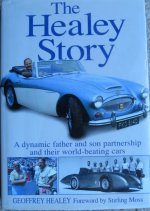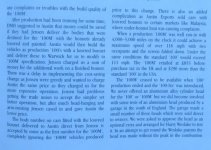This is an interesting discussion and I'm not trying to muddy the waters or undermine Reid's efforts to lay this out with clarity. As I said, I'm not a 100M expert, don't have a dog in the fight, but am just interested in the history. I've carefully read all the posts and understand the stated arguments. If I've made a wrong assumption, please feel free to correct it. Here's my points:
1. I totally agree with the conclusion that the only cars that can be documented as 100Ms are the 640 (more or less) that can be identified with "louvered bonnet" on the build card and as such, are given greater monetary value by collectors
2. If you use the build card notation as the lodestar of what constitutes a 100M, then no BN1 qualify as such. And given the proximity between the beginning of BN2 production with the appearance of the London Motor Show car, I believe it is a fair assumption that the "prelouvering" also began with the introduction of the BN2 and the likelihood of a BN2 100M that was not prelouvered is likely slim to none (this is not what I posited earlier, as I overlooked how close to the beginning of BN2 production the 100M appeared.
3. So here's another topic of discussion: I don't consider the "louvered bonnet" notation to be necessarily dispositive. Jensen was merely the builder of the body. They had no role in naming the car the 100M. In fact, nowhere on the build card does the term 100M exist. It was, from what we can read in The Healey Story, Donald who named the car the 100M. The best evidence of what was considered an M would come from Donald himself. Unfortunately, as far as I can tell, there is no such evidence. And certainly there are no internal memos that have ever been shown that would establish when DHMC started using the term 100M. But that's not to say they didn't exist, it only means they were probably destroyed with the dissolution of Healey production.
4. But this is interesting. Gary Anderson wrote an article entitled "The Heritage of the 100M" in the September-October 2012 issue of the Austin-Healey Magazine which states:
The Le Mans Modification Kit
. Following Jaguar’s lead with its own modified cars, DMH introduced a kit of tuning parts in late
1953 called the Le Mans Modification Kit, which was marketed under part number P.280 through BMC dealers. A two-page brochure was made up that advertised the Le Mans
Modification Kit. .....
Ever the marketer, soon after the kit was designed, DMH had begun a nice sideline business at his own dealership in Warwick. . Not only did he install the Le Mans Modification Kit on customers’ cars, but he also offered some options, including louvering on the bonnet and a neat little M badge that could be affixed with integrated wires to the 100 flash on the grille. At some point, DMH also began offering high-compression pistons, with a smaller dished area in the face of the piston, as an additional tuning option to further increase power. Testing of the kit with the high-com-pression pistons indicated a yield of 110 horsepower.
Unfortunately, Gary doesn't give a citation for the information that the M was being fixed to cars by DMH "soon after the kit was designed" and on cars with low compression pistons.
And with that, I'll butt out.

 Hi Guest!
Hi Guest!

 smilie in place of the real @
smilie in place of the real @
 Pretty Please - add it to our Events forum(s) and add to the calendar! >>
Pretty Please - add it to our Events forum(s) and add to the calendar! >> 



